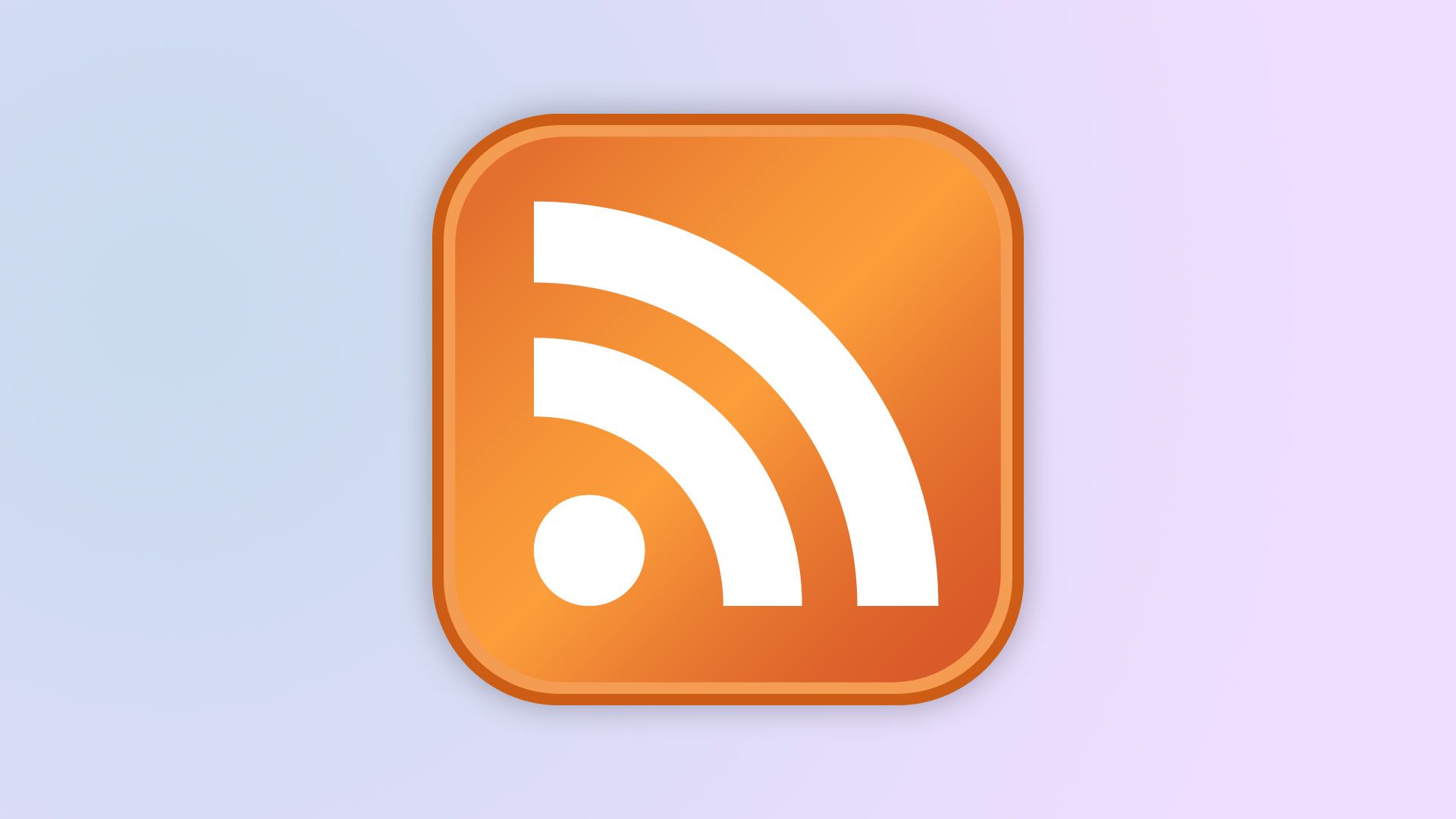Summary
- RSS (Really Simple Syndication) lets you subscribe to site feeds and receive new article notifications.
- RSS is an open and simple format, encouraging publishers to syndicate content for customized reading.
- Podcasts rely on RSS for syndication, and it’s a great alternative to social media feeds.
Catching up on the news means either dodging paywalls on traditional media sites, or wading through toxic comments on social media, right? Wrong: there’s another way. RSS has been keeping us informed for over two decades, and it’s as relevant today as ever.
RSS (Really Simple Syndication) is a technology that lets sites publish a feed of their content. As a reader, you can subscribe to an RSS feed and receive notifications when new articles are published, from news stories to social media updates.
Like the old Betamax format for videotapes, RSS is an example of a worse technology winning a format war, since the Atom alternative is, in many ways, superior. But most clients treat RSS and Atom interchangeably, so as a user, you don’t need to be aware of the difference.
I’ve been using RSS for as long as I can remember. Maybe not quite at launch—which was in 1999—but probably not that long after that, certainly for the last two decades. Here are the main reasons it remains my go-to for catching up online.
It’s Easy to Use
Because RSS is such a simple format, it’s very easy to use. Subscribing to a new feed is straightforward: copy the feed’s URL and paste it into your feed reader. Once you’ve done so, your reader will present the feed’s articles, notifying you when new content is published.
This simple process means there’s little to go wrong. When I find a feed I want to subscribe to, I just need a URL and an RSS client. Feeds can vary greatly between publishers: some provide full text, while others just include a summary, for example. But these differences are usually trivial and the experience of reading in a single app rather than switching between many different sites is well worth it.
I really started to appreciate the potential for RSS’s mass appeal when I worked for an education-related company. Our RSS feeds were incredibly popular, something which surprised me given the stereotypical aversion to technology that teachers are often assumed to have. But it turned out that schools, with their fancy digital whiteboards and thirst for topical information, were a perfect match for RSS.
The Simple Open Format
At its core, the RSS format is simple and accessible. Built on top of XML—a markup language similar, and sort of related, to HTML—RSS is an open format that anyone can work with. Just like HTML, you can view the text source of an RSS feed to debug it or learn from it. This also means that, if you’re so inclined, you can even author your own RSS feed by hand.
An RSS feed includes a list of items, each of which represents a story/article. Usually (although it’s not required), each item has a title, a link, a description, and a pubDate. So a sample item from the BBC’s RSS feed looks like this:
item>
title>
Lady Gaga and Pulp rumored for surprise Glastonbury sets as full
line-up revealed
title> link>
https://www.bbc.com/news/articles/cx2jd8e6918o
link>
description>
With three weeks to go, the UK's biggest festival unveils its full
line-up, plus a few mystery sets.
description>
pubDate>
Tue, 03 Jun 2025 09:00:15 GMT
pubDate>
item>
From a developer’s point of view, this simplicity is a huge bonus which, in turn, means site owners are much more likely to provide a feed. CMS software and web frameworks almost always include support for RSS feeds since it is so easy to provide.
I Can Read the News the Way I Want
RSS encourages publishers to syndicate their content in a common format. As a result, consumers can mix and match their feeds exactly as desired, in many different ways.
For example, most RSS clients will let you view either individual feeds or everything all together in one single feed. This is a bit like how Google’s Gmail gives you access to “all mail,” but also splits it up into Primary, Promotions, and Social. The difference is that RSS gives you the potential for much more flexibility.

Related
How to Automatically Move Gmail Messages to a Different Tab
Inbox getting out of hand? Organize your Gmail inbox by automatically moving emails to the right tabs.
A typical RSS client will let you group feeds into folders. This is an excellent opportunity to organize your reading. Maybe you want to group by subject matter, and separate your sports reading from your current affairs. Alternatively, you might want to separate frequently updated content that you dip into quickly from more long-form articles that publish less often, but with greater depth.
This can go much further, with some clients offering bookmarking functionality, AI feeds, and recently read or recently published groupings.
It’s Essential for Podcasts
One of the major reasons podcasts took off and have, just about, endured is their use of RSS as a foundation. Once more, the simple open format is to thank. Although podcasts are a very different type of medium, RSS can syndicate them, just as it can with traditional text-based articles.
Many RSS clients will cater specifically to podcasts. Even if they don’t, since a podcast is just an RSS feed, you’ll still be able to add them and follow a link to listen in an external app.
I Can Manage It Better Than Social Media
Most social media feeds are opinionated. On X, the “For You” feed decides which content to serve you based on a complex algorithm that tries to second-guess your interests. It can seem like magic, but many of us are concerned about how such algorithms work behind the scenes and what effect they are having, driving us to attention-grabbing content we might otherwise avoid.

Related
You’re Training Your Social Media Algorithm Every Day
If your social media news feed is a chaotic mess, you can do something about it!
RSS feeds are usually different. A site’s feed algorithm will often be as simple as “include an item for every article, in chronological order.” Unless a feed is specifically tailored to your user account, this is a one-feed-for-all approach that avoids the use of personal data.
Ironically, some social media apps provide RSS feeds, even though they may be a little hidden. Bluesky publishes a feed alongside every user account. For example, the official bsky.app account uses the URL https://bsky.app/profile/bsky.app. To subscribe to its RSS feed, simply add “/rss” to the URL, giving https://bsky.app/profile/bsky.app/rss.
It’s easy to start using RSS and there are plenty of clients to choose from.
Pick a Client
Feed readers tend to come in one of two forms: a web app or a native client. An RSS web app is useful because you can access it from different devices, but a native client can offer tighter integration with your OS.
On Mac, I’ve used two clients: Reeder and NetNewsWire. Reeder is a nice, polished app that looks and feels very much like a native Mac app. It does everything you need, but it requires a subscription ($10/year) to read more than ten feeds.
NetNewsWire is free and open source. My only complaint is that it doesn’t let you add a feed to more than one folder, but otherwise it’s perfect for my RSS needs.
On the web, Feedly is the most popular option and supports plenty of customization. Its free tier gives you 100 feeds and three folders. It also offers iOS and Android apps.

Related
RSS Feed in the Linux/Mac Terminal: Read the Latest With This CLI Tool
The cleed app is a tiny feed reader that does the job perfectly.
Find Feeds
Most RSS apps let you paste a website’s URL and will automatically find an RSS feed if one exists. Many sites publicize their RSS feed with a direct link; look out for the words “feed” and “RSS”, and the common RSS icon which looks like waves emanating from a circle, usually orange and white.
Your browser should also have extensions that support RSS. Google’s own RSS Subscription Extension is a good option for Chrome. It adds an icon to your toolbar that lights up when a feed is available, although I’ve found it doesn’t work 100% of the time.
Failing these options, you might have to resort to viewing the page source and manually searching for the feed URL. You’ll need to know exactly what you’re looking for, but you should rarely need to use this last resort if a site does have a feed.
















